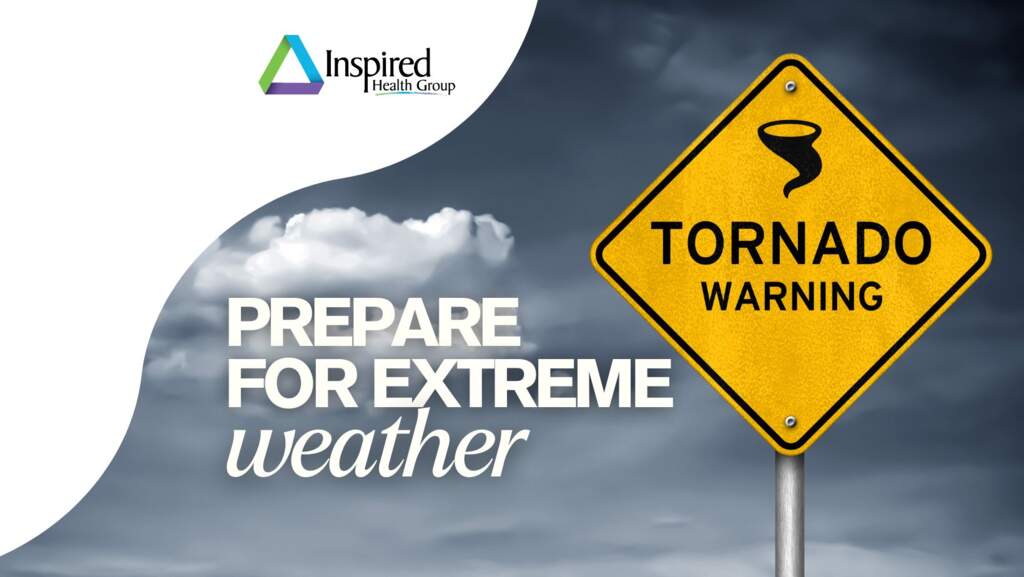Apr 28, 2025
What to do during a Tornado
The National Weather Service (NWS) has identified the possibility of severe weather on Tuesday afternoon and evening. Damaging wind gusts, large hail and a few tornadoes are all possible. Be weather aware and ready to act and have multiple ways to receive weather warnings on Tuesday. Learn what you can do to keep you and your loved ones safe during a tornado.
Prepare for a tornado:
Be Weather-Ready:
Check the forecast regularly to see if you're at risk for tornadoes. Listen to local news or a NOAA Weather Radio to stay informed about tornado watches and warnings. Check the Weather-Ready Nation for tips.
Know the difference between a tornado watch vs a tornado warning:
- A tornado WATCH means tornadoes are possible in and near your area. Be ready to act fast!
- A tornado WARNING means take action! A tornado is near. There is danger. Move to safe location right away.
Sign Up for Notifications:
Know how your community sends warnings. Some communities have outdoor sirens. Others depend on media and smart phones to alert residents of severe storms capable of producing tornadoes.
Erie County Residents may consider using:
- The ReadyErie App is available for Erie County residents to make and share emergency plans, as well as receive information from Erie County during emergencies.
- New Yorkers can subscribe for NY-Alert to receive critical information and emergency alerts on what is happening in their area. NY-Alert contains critical, emergency-related information including instructions and recommendations in real-time by emergency personnel. Information may include severe weather warnings, significant highway closures, hazardous material spills and other emergency conditions.
Create a Communications Plan:
Have a family plan that includes an emergency meeting place and related information. If you live in a mobile home or home without a basement, identify a nearby safe building you can get too quickly, such as a church or family member. Pick a safe room in your home, such as a basement, storm cellar, or an interior room on the lowest floor with no windows. Check more ideas for your family plan at: https://www.ready.gov/make-a-plan
Practice Your Plan:
Conduct a family severe thunderstorm drill regularly so everyone knows what to do if a tornado is approaching. Make sure all members of your family know to go there when tornado warnings are issued. Ensure your plans and drills include caring for pets.
Prepare Your Home:
Consider having your safe room reinforced. You can find plans for reinforcing an interior room to provide better protection on the Federal Emergency Management Agency website. Additionally, securing your home by with permanent storm shutters, impact-resistant garage doors, and sturdy exterior doors can add more protection
Build an emergency kit:
Prepare for long-term stay at home or sheltering in place by gathering emergency supplies, cleaning supplies, non-perishable foods, water, first aid and medical supplies and medication. Flashlights, batteries, a battery powered or hand crank radio and whistle are other helpful supplies in emergency kits.
Help others:
Encourage your loved ones to prepare for the possibility of tornadoes. Take CPR training so you can help if someone is hurt.
During a Tornado:
Stay Weather-Ready:
Continue to listen to local news or a NOAA Weather Radio to stay updated about tornado watches and warnings.
Protect yourself:
Covering your head or neck with your arms and putting materials such as furniture and blankets around or on top of you can offer some protection.
If you are at your house:
Immediately go to the safe location you have identified. This may be a your basement, safe room, or an interior room away from windows. Don't forget pets if time allows.
If you are at your workplace or school:
Follow your tornado drill and proceed to your tornado shelter location quickly and calmly. Stay away from windows and do not go to large open rooms such as cafeterias, gymnasiums, or auditoriums.
If you are outside:
Seek shelter inside a sturdy building immediately if a tornado is approaching. Sheds and storage facilities are not safe. Neither is a mobile home or tent. If you have time, get to a safe building.
If you are in a vehicle:
Being in a vehicle during a tornado is not safe. The best course of action is to drive to the closest shelter if time allows.
- If the tornado is visible, far away, and the traffic is light, you may be able to drive out of its path by moving at right angles to the tornado.
- If you are caught by extreme winds or flying debris, park the car as quickly and safely as possible -- out of the traffic lanes.
- Stay in the car with the seat belt on. Put your head down below the windows; cover your head with your hands and a blanket, coat, or other cushion if possible.
- If you can safely get noticeably lower than the level of the roadway, leave your car and lie in that area, covering your head with your hands.
- Avoid seeking shelter under bridges, which can create deadly traffic hazards while offering little protection against flying debris.
Use your devices wisely:
As you shelter in place, save your phone use for emergencies. Use calling, text messaging or social media to communicate with family and friends and for finding out critical information about the storm and it's path.
Learn more from:
